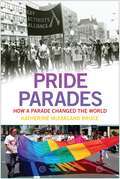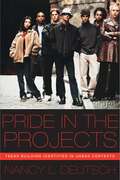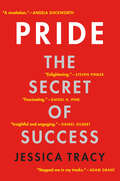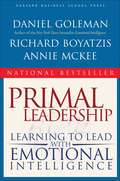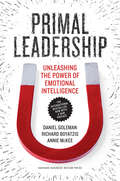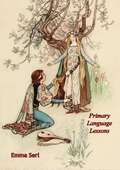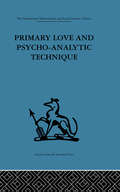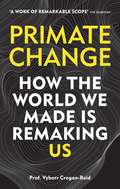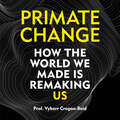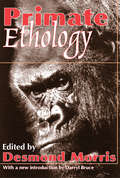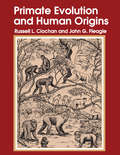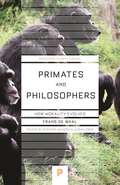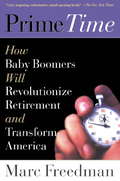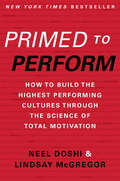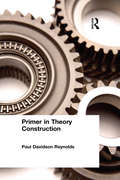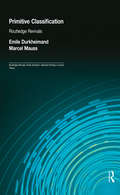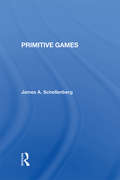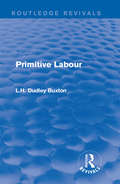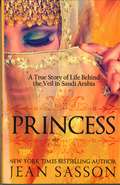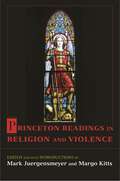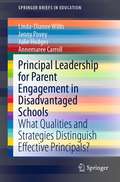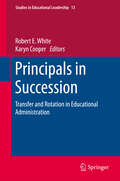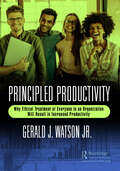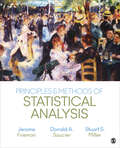- Table View
- List View
Pride Parades: How a Parade Changed the World
by Katherine McFarland BruceOn June 28, 1970, two thousand gay and lesbian activists in New York, Los Angeles, and Chicago paraded down the streets of their cities in a new kind of social protest, one marked by celebration, fun, and unashamed declaration of a stigmatized identity. Forty-five years later, over six million people annually participate in 115 Pride parades across the United States. They march with church congregations and college gay-straight alliance groups, perform dance routines and marching band numbers, and gather with friends to cheer from the sidelines. With vivid imagery, and showcasing the voices of these participants, Pride Parades tells the story of Pride from its beginning in 1970 to 2010. Though often dismissed as frivolous spectacles, the author builds a convincing case for the importance of Pride parades as cultural protests at the heart of lesbian, gay, bisexual, and transgender (LGBT) community. Weaving together interviews, archival reports, quantitative data, and ethnographic observations at six diverse contemporary parades in New York City, Salt Lake City, San Diego, Burlington, Fargo, and Atlanta, Bruce describes how Pride parades are a venue for participants to challenge the everyday cultural stigma of being queer in America, all with a flair and sense of fun absent from typical protests. Unlike these political protests that aim to change government laws and policies, Pride parades are coordinated, concerted attempts to improve the standing of LGBT people in American culture.
Pride in the Projects: Teens Building Identities in Urban Contexts (Qualitative Studies in Psychology #5)
by Nancy L. DeutschTeens in America’s inner cities grow up and construct identities amidst a landscape of relationships and violence, support and discrimination, games and gangs. In such contexts, local environments such as after-school programs may help youth to mediate between social stereotypes and daily experience, or provide space for them to consider themselves as contributing members of a community.Based on four years of field work with both the adolescent members and staff of an inner-city youth organization in a large Midwestern city, Pride in the Projects examines the construction of identity as it occurs within this local context, emphasizing the relationships within which identities are formed. Drawing on research in psychology, sociology, education, and race and gender studies, the volume highlights the inadequacies in current identity development theories, expanding our understanding of the lives of urban teens and the ways in which interpersonal connections serve as powerful contexts for self-construction. The adolescents’ stories illuminate how they find ways to discover who they are, and who they would like to be — in positive and healthy ways — in the face of very real obstacles. The book closes with implications for practice, alerting scholars, educators, practitioners, and concerned citizens of the positive developmental possibilities inherent in youth settings when we pay attention to the voices of youth.
Pride: The Secret of Success
by Jessica Tracy“Jessica Tracy has flipped the script on pride, showing that it’s not just a deadly sin to be avoided, but also a vitalizing virtue to be nurtured.” —Robert Cialdini, New York Times–bestselling author of InfluenceWhy did Paul Gauguin abandon middle-class life to follow the path of a starving artist? What explains the massive success of Steve Jobs, a man with great ideas but weak programming skills and a questionable managerial style? How did Dean Karnazes—the famed “Ultramarathon Man”—transform himself from a directionless desk jockey into an extreme athlete who once ran fifty marathons in fifty days? As the renowned emotion researcher Jessica Tracy reveals, each of these superachievers has been motivated by an often maligned emotion: pride. Its dark, hubristic side is well known, but Tracy shows that pride is also essential for helping us become our best, brightest selves. It makes us strive for excellence. In the right doses and the right contexts, it has been proven to boost creativity, motivate altruism, and confer power and prestige on those who display it. In Pride, Tracy explains how we can make this double-edged emotion serve us—rather than the other way around.Previously published in hardcover as Take Pride“A revelation. A renowned psychologist, Jessica Tracy explains that seeking our best self is nothing to be ashamed of, but that seeking praise at all costs gets us into the worst kind of trouble” —Angela Duckworth, #1 New York Times–bestselling author of Grit“Fascinating . . . Tracy uses original research to show that pride is a major part of what it means to be human and can be harnessed as a force for good.” —Daniel H. Pink, New York Times–bestselling author of Drive
Primal Leadership, With a New Preface by the Authors
by Daniel Goleman Annie Mckee Richard BoyatzisThis is the book that established "emotional intelligence" in the business lexicon-and made it a necessary skill for leaders.Managers and professionals across the globe have embraced Primal Leadership, affirming the importance of emotionally intelligent leadership. Its influence has also reached well beyond the business world: the book and its ideas are now used routinely in universities, business and medical schools, and professional training programs, and by a growing legion of professional coaches.This refreshed edition, with a new preface by the authors, vividly illustrates the power-and the necessity-of leadership that is self-aware, empathic, motivating, and collaborative in a world that is ever more economically volatile and technologically complex. It is even timelier now than when it was originally published.From bestselling authors Daniel Goleman, Richard Boyatzis, and Annie McKee, this groundbreaking book remains a must-read for anyone who leads or aspires to lead.Also available in ebook format wherever ebooks are sold.
Primary Language Lessons
by Emma SerlAlong with Charlotte Mason, Serl's work is considered one of the more lasting classics on Home Schooling. "Primary Language Lessons" deals with word usage, punctuation, capitalization, abbreviations, contractions, letter writing, memorization and recitation of poetry, retelling or rewriting of brief narratives, copy-work, and dictation. Overall emphasis is upon proper word usage in both spoken and written communication. Beautiful artwork reproductions (in black and white) are used as the basis for a number of lessons as are myths, legends, fables, fairy tales, historical vignettes, biographies, Bible stories, and nature lessons. This work is intended for second and third graders.-Print ed.
Primary Love and Psycho-Analytic Technique (International Behavioural And Social Sciences Ser. #Vol. 88)
by Michael BalintTavistock Press was established as a co-operative venture between the Tavistock Institute and Routledge & Kegan Paul (RKP) in the 1950s to produce a series of major contributions across the social sciences. This volume is part of a 2001 reissue of a selection of those important works which have since gone out of print, or are difficult to locate. Published by Routledge, 112 volumes in total are being brought together under the name The International Behavioural and Social Sciences Library: Classics from the Tavistock Press. Reproduced here in facsimile, this volume was originally published in 1965 and is available individually. The collection is also available in a number of themed mini-sets of between 5 and 13 volumes, or as a complete collection.
Primate Change: How the world we made is remaking us
by Vybarr Cregan-Reid'A work of remarkable scope' - GuardianFT Best science books of 2018Primate Change has been adapted into a radio series for the BBC WORLD SERVICE.*This is the road from climate change to primate change.PRIMATE CHANGE is a wide-ranging, polemical look at how and why the human body has changed since humankind first got up on two feet. Spanning the entirety of human history - from primate to transhuman - Vybarr Cregan-Reid's book investigates where we came from, who we are today and how modern technology will change us beyond recognition.In the last two hundred years, humans have made such a tremendous impact on the world that our geological epoch is about to be declared the 'Anthropocene', or the Age of Man. But while we have been busy changing the shape of the world we inhabit, the ways of living that we have been building have, as if under the cover of darkness, been transforming our bodies and altering the expression of our DNA, too.Primate Change beautifully unscrambles the complex architecture of our modern human bodies, built over millions of years and only starting to give up on us now.'Our bodies are in a shock. Modern living is as bracing to the human body as jumping through a hole in the ice. Our bodies do not know what century they were born into and they are defending and deforming themselves in response.'
Primate Change: How the world we made is remaking us
by Vybarr Cregan-ReidIF YOU THINK YOU ARE YOU, THINK AGAIN.PRIMATE CHANGE is a wide-ranging, polemical look at how and why the human body has changed since humankind first got up on two feet. Spanning the entirety of human history - from primate to transhuman - Vybarr Cregan-Reid's book investigates where we came from, who we are today and how modern technology will change us beyond recognition.In the last two hundred years, humans have made such a tremendous impact on the world that our geological epoch is about to be declared the 'Anthropocene', or the Age of Man. But while we have been busy changing the shape of the world we inhabit, the ways of living that we have been building have, as if under the cover of darkness, been transforming our bodies and altering the expression of our DNA, too.PRIMATE CHANGE beautifully unscrambles the complex architecture of our modern human bodies, built over millions of years and only starting to give up on us now.'Our bodies are in a shock. Modern living is as bracing to the human body as jumping through a hole in the ice. Our bodies do not know what century they were born into and they are defending and deforming themselves in response'
Primate Change: How the world we made is remaking us
by Vybarr Cregan-ReidIF YOU THINK YOU ARE YOU, THINK AGAIN.PRIMATE CHANGE is a wide-ranging, polemical look at how and why the human body has changed since humankind first got up on two feet. Spanning the entirety of human history - from primate to transhuman - Vybarr Cregan-Reid's book investigates where we came from, who we are today and how modern technology will change us beyond recognition.In the last two hundred years, humans have made such a tremendous impact on the world that our geological epoch is about to be declared the 'Anthropocene', or the Age of Man. But while we have been busy changing the shape of the world we inhabit, the ways of living that we have been building have, as if under the cover of darkness, been transforming our bodies and altering the expression of our DNA, too.PRIMATE CHANGE beautifully unscrambles the complex architecture of our modern human bodies, built over millions of years and only starting to give up on us now.'Our bodies are in a shock. Modern living is as bracing to the human body as jumping through a hole in the ice. Our bodies do not know what century they were born into and they are defending and deforming themselves in response'(p) 2018 Octopus Publishing Group
Primate Ethology
by Pendleton HerringThis is a groundbreaking workwhich brought together studiesof monkeys and apes from boththe laboratory and the field. Manybroad aspects of primate life,including facial expressions,sexual signals, grooming, play,social organization and parental care, are covered bythe contributors and provided a whole new approach toprimate behavior.
Primate Evolution and Human Origins
by Russell L. CiochonPrimate Evolution and Human Origins compiles, for the first time, the major ideas and publications that have shaped our current view of the evolutionary biology of the primates and the origin of the human line. Designed for freshmen-to-graduate students in anthropology, paleontology, and biology, the book is a unique collection of classic papers, culled from the past 20 years of research. It is also an important reference for academicians and researchers, as it covers the entire scope of primate and human evolution (with an emphasis on the fossil record). A comprehensive bibliography cites over 2000 significant articles not found in the main text.
Primates and Philosophers: How Morality Evolved (Princeton Science Library #43)
by Frans de WaalCan virtuous behavior be explained by nature, and not by human rational choice? "It's the animal in us," we often hear when we've been bad. But why not when we're good? Primates and Philosophers tackles this question by exploring the biological foundations of one of humanity's most valued traits: morality. In this provocative book, renowned primatologist Frans de Waal argues that modern-day evolutionary biology takes far too dim a view of the natural world, emphasizing our "selfish" genes and reinforcing our habit of labeling ethical behavior as humane and the less civilized as animalistic. Seeking the origin of human morality not in evolution but in human culture, science insists that we are moral by choice, not by nature. Citing remarkable evidence based on his extensive research of primate behavior, de Waal attacks "Veneer Theory," which posits morality as a thin overlay on an otherwise nasty nature. He explains how we evolved from a long line of animals that care for the weak and build cooperation with reciprocal transactions. Drawing on Darwin, recent scientific advances, and his extensive research of primate behavior, de Waal demonstrates a strong continuity between human and animal behavior. He probes issues such as anthropomorphism and human responsibilities toward animals. His compelling account of how human morality evolved out of mammalian society will fascinate anyone who has ever wondered about the origins and reach of human goodness. Based on the Tanner Lectures de Waal delivered at Princeton University's Center for Human Values in 2004, Primates and Philosophers includes responses by the philosophers Peter Singer, Christine M. Korsgaard, and Philip Kitcher and the science writer Robert Wright. They press de Waal to clarify the differences between humans and other animals, yielding a lively debate that will fascinate all those who wonder about the origins and reach of human goodness.
Prime Time: How Baby Boomers Will Revolutionize Retirement And Transform America
by Marc FreedmanOver the next three decades, the number of Americans over fifty will double, swelling to more than a quarter of the population. Already we are living thirty years longer than a century ago, with further gains expected in the coming years. The end result is a new stage of life, one as long or longer than childhood or middle age in duration, and one spent in unprecedented good health. Yet, as individuals, and as a society, we've shown little imagination or wisdom in using this great gift of a third age. Marc Freedman identifies the new longevity as not a problem to be solved, but an opportunity to be seized-provided we can engage the experience, talent, and idealism of older Americans. At a juncture when the middle-generation faces a time-famine, struggling to simultaneously raise kids and work long hours on the job, the older generation is awash in free time, poised to succeed women as the trustees of civic life in this country. In the process they stand to find new meaning and purpose in their lives, and abandon the limbo-like state unfulfilling for so many older individuals. Freedman argues that the aging phenomenon, the massive transformation that many portray as our downfall, may in fact be our best hope for renewal as a nation.
Primed to Perform: How to Build the Highest Performing Cultures Through the Science of Total Motivation
by Lindsay Mcgregor Neel DoshiWhy do some workplace cultures inspire energy and innovation, while others fuel anxiety, boredom, or cynicism? Until now, such legendary cultures have seemed like magic beyond our control. However, behind every culture is a surprisingly elegant science. Primed to Perform proves that the highest-performing cultures are built on a simple truth: why people work affects how well they work. Great organizations inspire the three most powerful motives for work--play, purpose, and potential--and eliminate the three most destructive--emotional pressure, economic pressure, and inertia. They create total motivation (or ToMo, for short). Total motivation cultures create the highest-performing employees and the most adaptive organizations.Authors Neel Doshi and Lindsay McGregor show that extraordinary performance at companies like Southwest Airlines, Starbucks, Apple, and Whole Foods comes from cultures that inspire total motivation. They describe how investment professionals, salespeople, teachers, and CEOs perform better when driven by total motivation. And, most important, they share how you can build a culture that inspires total motivation in every moment of every day.Primed to Perform builds on over a century of academic thinking as well as the authors' original research into how ToMo drives performance at iconic companies. It introduces the authors' highly predictive new measurement tool, the total motivation factor, which allows leaders to measure the strength of their culture and understand how it changes over time. It gives leaders the tools to transform their own workplaces.High-performing cultures can't be left to chance; organizations must create systems that shape and maintain them. Whether you're a five-person team or a start-up, an elementary school or a university, a nonprofit or a mega-institution, Primed to Perform shows you how.
Primer in Theory Construction: An A&B Classics Edition
by Paul Davidson ReynoldsA Primer in Theory Construction is for those who have already studied one or more of the social, behavioral, or natural sciences, but have no formal introduction to the way theories are constructed, stated, tested, and connected together to form a scientific body of knowledge. The author discusses scientific theories in general terms, but also addresses the special challenges of developing scientific knowledge about social and human phenomena. This Allyn and Bacon Classics Edition contains the complete text of the original copyright 1971 version, with new typography and page design.
Primitive Classification (Routledge Revivals: Emile Durkheim: Selected Writings in Social Theory)
by Emile Durkheim Marcel MaussIn this influential work, first published in English in 1963, Durkheim and Mauss claim that the individual mind is capable of classification and they seek the origin of the ‘classificatory function’ in society. On the basis of an intensive examination of forms and principles of symbolic classification reported from the Australian aborigines, the Zuñi and traditional China, they try to establish a formal correspondence between social and symbolic classification. From this they argue that the mode of classification is determined by the form of society and that the notions of space, time, hierarchy, number, class and other such cognitive categories are products of society. Dr Needham’s introduction assesses the validity of Durkhiem and Mauss’s argument, traces its continued influence in various disciplines, and indicates its analytical value for future researches in social anthropology.
Primitive Games
by James A SchellenbergThis book shows how primitive games relate to the broader framework of the theory of games and provides a general discussion of the different types of primitive games. It deals with applications of primitive games to particular areas of social research.
Primitive Labour (Routledge Revivals)
by L.H. Dudley BuxtonOriginally published in 1924, Dudley Buxton explores the evolution of primitive societies in relation to labour. This is mostly done by studying primitive inventions to try and understand how each of these inventions was used to contribute to everyday living and to develop the society’s material culture. This study places an emphasis on understanding the importance of various industrial tools to societies in relation to different industries and geographical factors such as climate. This title will be of interest to students of Anthropology.
Princess: A True Story of Life Behind the Veil in Saudi Arabia
by Jean SassonThis is a true story of life behind the veil for princess Sultana in Saudi Arabia. Book 1 in the trilogy
Princeton Readings in Religion and Violence
by Mark Juergensmeyer Margo KittsAn anthology that examines the historical and contemporary relationship between religion and violenceThis groundbreaking anthology provides the most comprehensive overview for understanding the fascinating relationship between religion and violence—historically, culturally, and in the contemporary world. Bringing together writings from scholarly and religious traditions, it is the first volume to unite primary sources—justifications for violence from religious texts, theologians, and activists—with invaluable essays by authoritative scholars.The first half of the collection includes original source materials justifying violence from various religious perspectives: Hindu, Chinese, Christian, Muslim, Jewish, and Buddhist. Showing that religious violence is found in every tradition, these sources include ancient texts and scriptures along with thoughtful essays from theologians wrestling with such issues as military protection and pacifism. The collection also includes the writings of modern-day activists involved in suicide bombings, attacks on abortion clinics, and nerve gas assaults. The book's second half features well-known thinkers reflecting on why religion and violence are so intimately related and includes excerpts from early social theorists such as Durkheim, Marx, and Freud, as well as contemporary thinkers who view the issue of religious violence from literary, anthropological, postcolonial, and feminist perspectives. The editors' brief introductions to each essay provide important historical and conceptual contexts and relate the readings to one another. The diversity of selections and their accessible length make this volume ideal for both students and general readers.
Principal Leadership for Parent Engagement in Disadvantaged Schools: What Qualities and Strategies Distinguish Effective Principals? (SpringerBriefs in Education)
by Annemaree Carroll Julie Hodges Linda-Dianne Willis Jenny PoveyThis book presents and theorises research findings into why and how school principals play a critical role in engaging parents and their school communities to enhance student learning and wellbeing. It highlights the imperative of parent engagement as evidenced by clear, consistent findings from research over the last fifty years and government reforms, policies and frameworks internationally and nationally in Australia which have been driven by the weight of this evidence. It focuses on a research project conducted from 2016 to 2017, titled 'Principal leadership for parent-school-community engagement in disadvantaged schools'. This project investigated four principals identified as successful in parent engagement based on findings of state-wide survey research of principals and presidents of parents and citizens’ associations in 2014 in Queensland, Australia. This book offers theoretical and empirical evidence based on literature for the qualities successful principals in parent engagement exhibit, and the strategies they take to achieve parent and community engagement. It shows how the concept of agency as achievement can be used by educators and public policy makers to enable school leaders and teachers to adopt qualities and strategies that will engage parents in their child’s learning and wellbeing, so that improved outcomes for their child and schools can result.
Principals in Succession
by Robert E. White Karyn CooperContributors to this volume examine structures and processes that school boards have in place directly relating to the process of principal or vice-principal succession. As well, they consider the effect that these structures and processes have upon staff and administrators themselves. These contributors investigate policies, procedures and practices that school boards employ in terms of leadership succession, and explore implications of these constructs for the sustainability of school improvement. This volume presents an overview of the process of principal or vice-principal succession, descriptions of school district practices surrounding this process and discussions regarding how succession procedures affect individuals and groups of individuals. This volume also highlights those board policies that incorporate practices used to develop models that support and allow administrators to succeed. It articulates how school leaders and staff members deal with change and improvement efforts in successive schools, as well as how board policies and practices support principals and vice-principals at any stage in the succession process. This volume is useful as a reference guide relating to transfer and rotation procedures in school systems across the nation.
Principled Productivity: Why Ethical Treatment of Everyone in an Organization Will Result in Increased Productivity
by Gerald J. Watson Jr.This book demonstrates that ethical treatment of everyone in an organization: 1. Will increase productivity in all the functional activities of the organization as well as its members. 2. Will ensure the growth of the organization as a result of continuous improvements that may have been initiated by management but will be continuously improved by motivated employees. It achieves this by: 1. The presentation of examples from personal experience and a review of the literature. 2. Providing a list of critical questions for each function whose correct solutions will provide a metric that enables and establishes obtainable goals for improvement. This book is unique because it requires the decision-maker to examine each potential decision and ask the questions: 1. Do alternative methods exist that will achieve the desired goals, which will minimize the long-term adverse effects on affected employees and the future viability of the organization? 2. When is the appropriate time to implement this decision? 3. What is the best way to implement this decision? The decision may involve a reduction in force (RIF), a potential change in a vendor or a manufacturing process, the formation of a safety team, and/or the installation or modification of an incentive system. The decisions could be involved in manufacturing, logistics, quality, or healthcare. This work will benefit everyone in leadership positions in all branches of government, manufacturing, logistics, human relations, and healthcare, especially those working with frontline employees, staff, and customers.
Principles & Methods of Statistical Analysis
by Jerome Frieman Donald A. Saucier Mr Stuart S. MillerThis unique intermediate/advanced statistics text uses real research on antisocial behaviors, such as cyberbullying, stereotyping, prejudice, and discrimination, to help readers across the social and behavioral sciences understand the underlying theory behind statistical methods. By presenting examples and principles of statistics within the context of these timely issues, authors Jerome Frieman, Donald A. Saucier, and Stuart S. Miller show how the results of analyses can be used to answer research questions. New techniques for data analysis and a wide range of topics are covered, including how to deal with “messy data” and the importance of engaging in exploratory data analysis.
